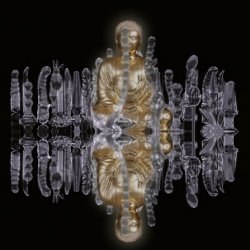Kuan
Kuan - a Chinese word which means contemplating and looking into underlying reality of all things. ‘Kuan’ is both a State and an Act of Contemplation
The word ‘kuan’ as used in Chinese Ch’an practice and in esoteric practice carries different meanings respectively.
In Ch’an practices, it is a noun, meaning a realized state of contemplation manifested after a practitioner has eliminated all his illusions through the practice of vipassana or Ch’an. Such a state can be manifested as heterodox or orthodox, or as imperfect or perfect. The practitioner must then follow the guidance of his guru, carefully compare his realized state with what is written and taught in the sutras, and adhere to what is orthodox and perfect so as to enter the state of samadhi in real life.
In esoteric practices, however, the word ‘kuan’ refers to an act of immersing oneself in a physical and mental state so as to achieve contemplated reality. The practitioner puts himself in real life situations to carry out such an acts of contemplation according to esoterics. Thus esoteric Buddhism emphasizes ‘kuan’, both in action and at rest.
Moreover, in esoteric practices, special emphases are placed on the arrangement of the altar and use of mandalas. The four main classes of mandalas used in esoteric practices are (1) the maha-mandalas, representing the Buddha statue or image, (2) the Dharma or seed mandalas, representing the seed syllables of the mantras as embodiment of sutra texts, (3) the samaya mandalas, representing the instruments and mudras used in the ceremonial practices, and (4) karma mandalas, representing the descriptions or expressions of actions and accomplishments of of the Buddha having the function of cause and effect. All of such mandalas are used in association with mudras, mantras, and Dharma texts, forming the ‘Triple Dharma Seals of the True Reality, ‘ ‘the One who has no second,’ ‘the Absolute Reality’ through the union of the ‘Three Vajras’ of body, speech, and mind. A practitioner is thus able to enter the state of the Dharmakaya.
